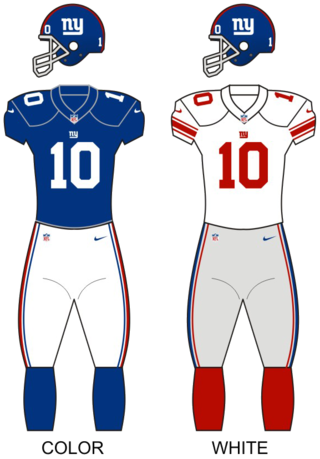
The New York Giants are a professional American football team based in the New York metropolitan area. The Giants compete in the National Football League (NFL) as a member club of the league's National Football Conference (NFC) East division. The team plays its home games at MetLife Stadium at the Meadowlands Sports Complex in East Rutherford, New Jersey, 5 miles (8 km) west of New York City. The stadium is shared with the New York Jets. The Giants are headquartered and practice at the Quest Diagnostics Training Center, also in the Meadowlands.
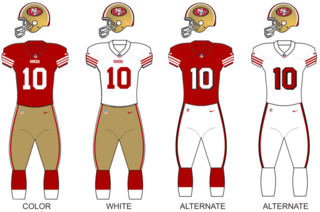
The San Francisco 49ers is a professional American football team based in the San Francisco Bay Area. The 49ers compete in the National Football League (NFL) as a member of the league's National Football Conference (NFC) West division, and play their home games at Levi's Stadium in Santa Clara, California, located 38 miles (61 km) southeast of San Francisco. The team is named after the prospectors who arrived in Northern California in the 1849 Gold Rush.
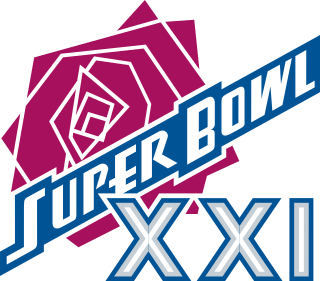
Super Bowl XXI was an American football game between the American Football Conference (AFC) champion Denver Broncos and the National Football Conference (NFC) champion New York Giants to decide the National Football League (NFL) champion for the 1986 season. It was the 21st Super Bowl and was played on January 25, 1987, at the Rose Bowl in Pasadena, California. The Giants defeated the Broncos, 39–20, for their first Super Bowl and first NFL title since 1956. It was the first of consecutive Super Bowl losses for the Broncos, who lost the Super Bowl a year later 42–10 to the Washington Redskins.

Super Bowl XXV was an American football game between the American Football Conference (AFC) champion Buffalo Bills and the National Football Conference (NFC) champion New York Giants to decide the National Football League (NFL) champion for the 1990 season. The Giants defeated the Bills by the score of 20–19, winning their second Super Bowl.

Super Bowl XXIX was an American football game between the American Football Conference (AFC) champion San Diego Chargers and the National Football Conference (NFC) champion San Francisco 49ers to decide the National Football League (NFL) champion for the 1994 season. The 49ers defeated the Chargers by the score of 49–26, becoming the first team to win five Super Bowl championships. The game was played on January 29, 1995, at Joe Robbie Stadium in Miami, Florida. In turn, this was the first Super Bowl to be played in that area after Hurricane Andrew ravaged the city in 1992.
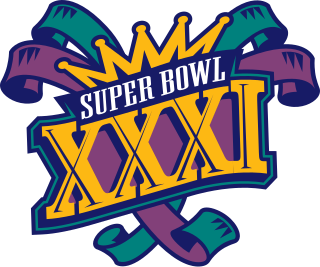
Super Bowl XXXI was an American football game between the American Football Conference (AFC) champion New England Patriots and the National Football Conference (NFC) champion Green Bay Packers to decide the National Football League (NFL) champion for the 1996 season. The Packers defeated the Patriots by the score of 35–21, earning their third overall Super Bowl victory, and their first since Super Bowl II. The Packers also extended their league record for the most overall NFL championships to 12. It was also the last in a run of 13 straight Super Bowl victories by the NFC over the AFC. The game was played on January 26, 1997, at the Louisiana Superdome in New Orleans, Louisiana.

Super Bowl XXXV was an American football game between the American Football Conference (AFC) champion Baltimore Ravens and the National Football Conference (NFC) champion New York Giants to decide the National Football League (NFL) champion for the 2000 season. The Ravens defeated the Giants by a score of 34–7, tied for the seventh largest Super Bowl margin of victory with Super Bowl XXXVII. The game was played on January 28, 2001, at Raymond James Stadium in Tampa, Florida, making it the first time Raymond James Stadium has held a Super Bowl.

Duane Charles "Bill" Parcells is a former American football coach who served as a head coach in the National Football League (NFL) for 19 seasons. He came to prominence as the head coach of the New York Giants from 1983 to 1991, where he won two Super Bowl titles. Parcells was later the head coach of the New England Patriots from 1993 to 1996, the New York Jets from 1997 to 2000, and the Dallas Cowboys from 2003 to 2006. Nicknamed "the Big Tuna", he is the only NFL coach to lead four different franchises to the playoffs and three to a conference championship game.
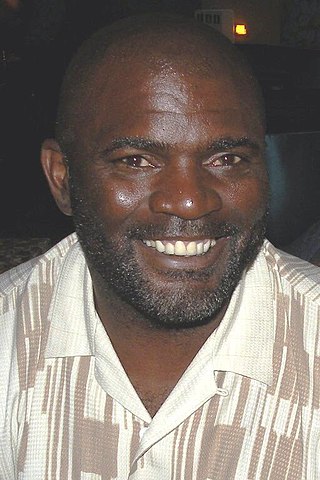
Lawrence Julius Taylor, nicknamed "L.T.", is a former American football linebacker who spent his entire career playing for the New York Giants in the National Football League (NFL). He is widely regarded as the greatest defensive player of all time.
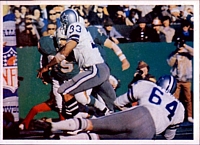
The National Football League playoffs for the 1971 season began on December 25, 1971. The postseason tournament concluded with the Dallas Cowboys defeating the Miami Dolphins in Super Bowl VI, 24–3, on January 16, 1972, at Tulane Stadium in New Orleans, Louisiana.

The New York Giants, an American football team which currently plays in the National Football League (NFL)'s National Football Conference (NFC), has a history dating back more than 80 seasons, with 4 Super Bowl victories. The Giants were founded in 1925 by Tim Mara in the then five-year-old NFL. Mara owned the team until his death in 1959, when it was passed on to his sons, Wellington and Jack. During their history, the Giants have won eight NFL championships, four of which came in Super Bowls.
James P. Burt is an American former professional football player who was a nose tackle for the New York Giants and San Francisco 49ers of the National Football League (NFL). Burt was a member of the Giants team that won Super Bowl XXI and the 49ers team that won Super Bowl XXIV. He played college football for the Miami Hurricanes.
This article contains an in-depth explanation of the history of the Dallas Cowboys, a professional American football team that competes in the National Football League (NFL).
The San Francisco 49ers are the first major league professional sports franchise to be based in San Francisco, and one of the first professional sports teams based on the West Coast of the United States.

The period of 1979 to 1993 was one of the most successful in New York Giants franchise history. Members of the NFL's National Football Conference, the Giants struggled after reaching the NFL Championship Game in 1963. The 1964 season began a 15-year stretch in which the Giants were unable to make the playoffs. However, in 1979 they started rebuilding, hiring General Manager George Young, the first GM in the family-run team's history. Young, a former Baltimore Colts and Miami Dolphins executive, assembled a team that would become successful in the 1980s and early 1990s. Led by a run-oriented offense and a defense nicknamed the "Big Blue Wrecking Crew", the team qualified for the postseason six times in 10 seasons from 1981 to 1990. During that period, they won Super Bowl XXI (1987) and Super Bowl XXV (1991).
The 1986 season was the New York Giants' 62nd in the National Football League (NFL) and their fourth under head coach Bill Parcells. The New York Giants, who play in the National Football Conference (NFC) of the National Football League (NFL), won their fifth championship—and first Super Bowl—in franchise history during the season. Led by consensus league Most Valuable Player (MVP) linebacker Lawrence Taylor and Super Bowl MVP quarterback Phil Simms, the Giants posted a 14–2 record during the regular season, tied for the best record in the league with the defending Super Bowl champion Chicago Bears and the best in team history. The Giants improved on their 10–6 record from 1985, won their first division championship since the NFL-AFL merger in 1970, and won Super Bowl XXI against the Denver Broncos.
The 1990 New York Giants season was the franchise's 66th season in the National Football League (NFL). The Giants, who play in the National Football Conference (NFC), won their sixth championship and second Super Bowl. Led by linebacker Lawrence Taylor and quarterbacks Phil Simms and Jeff Hostetler, the Giants posted a 13–3 record before defeating the Chicago Bears and the two-time defending Super Bowl champion San Francisco 49ers in the NFC playoffs. In Super Bowl XXV, they defeated the Buffalo Bills 20–19 in Tampa Stadium against a patriotic backdrop inspired by the recently started Gulf War. The story of the season is the subject of a recent book, When the Cheering Stops, by defensive end Leonard Marshall and CBSsports.com co-writer William Bendetson.
The 1993 New York Giants season was the franchise's 69th season in the National Football League (NFL) and the first under head coach Dan Reeves, who was hired by the Giants after being fired by the Denver Broncos in the off-season.

The 49ers–Giants rivalry is an American football rivalry between the San Francisco 49ers and the New York Giants. It is one of the great inter-division rivalry games in the National Football League (NFL). The two teams do not play each other every year; instead, they play at least once every three years and at least once every six seasons at each team's home stadium, sometimes more often if the two teams finish in the same place in their respective divisions or meet in the playoffs. Since 1982, the 49ers and Giants have met eight times in the postseason, tied for the most times two teams have met in the playoffs in the NFL since that time.

The Bears–Giants rivalry is a National Football League (NFL) rivalry between the Chicago Bears and the New York Giants. The rivalry was notable for the six NFL championship games between the two teams prior to the creation of the Super Bowl, and the two subsequent Super Bowl-era playoff meetings that involved two of the NFL's greatest defensive units: the Bears' 46 defense crew helmed by Buddy Ryan, and the Giants' Big Blue Wrecking Crew mentored by Bill Belichick.